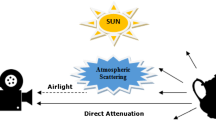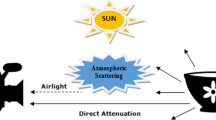Abstract
There exist multiple dehazed images corresponding to a single hazy image due to ill-posed nature of single image dehazing (SID), making it a challenging problem. Usually, the SID used atmospheric scattering model (ASM) to obtain haze-free image from a hazy image. According to ASM, recovery of lost visibility depends upon accurate transmission. The proposed method presents a linear multiplicative bounding function (MBF) for estimation of difference channel (DC) to compute the value of transmission. The results obtained by the MBF has been compared with renowned SID methods. The accuracy of the proposed MBF has been proved by visual and objective evaluation of the dehazed images.















Similar content being viewed by others
References
Berman D, Treibitz T, Avidan S (2016) Non-local image dehazing. In: IEEE Conference on computer vision and pattern recognition, pp 1674–1682
Cai B, Xu X, Jia K, Qing C, Tao D (2016) Dehazenet: an end-to-end system for single image haze removal. IEEE Trans Image Process 25(11):5187–5198
Engin D, Genc A, Ekenel H (2018) Cycle-dehaze: Enhanced cyclegan for single image dehazing. In: IEEE Conference on computer vision and pattern recognition, pp 938–9388
He K, Sun J, Tang X (2011) Single image haze removal using dark channel prior. IEEE Trans Pattern Anal Mach Intell 33(12):2341–2353
He K, Sun J, Tang X (2012) Guided image filtering. IEEE Trans Pattern Anal Mach Intell 35(6):1397–1409
Jha DK, Gupta B, Lamba SS (2016) L2-norm-based prior for haze-removal from single image. IET Comput Vis 10(5):331–341
Kim J-H, Jang W-D, Sim J-Y, Kim C-S (2013) Optimized contrast enhancement for real-time image and video dehazing. J Vis Commun Image Represent 24(3):410–425
Li C, Guo C, Guo J, Han P, Fu H, Cong R (2019) Pdr-net: Perception-inspired single image dehazing network with refinement. IEEE Trans Multimed:1–1
Li C, Guo J, Porikli F, Fu H, Pang Y (2018) A cascaded convolutional neural network for single image dehazing. IEEE Access 6:24 877–24 887
Li Y, Miao Q, Song J, Quan Y, Li W (2016) Single image haze removal based on haze physical characteristics and adaptive sky region detection. Neurocomputing 182:221–234. [Online] Available: http://www.sciencedirect.com/science/article/pii/S0925231215019694
Li B, Peng X, Wang Z, Xu J, Feng D (2017) Aod-net: All-in-one dehazing network. In: IEEE International conference on computer vision, pp 4780–4788
Li B, Ren W, Fu D, Tao D, Feng D, Zeng W, Wang Z (2019) Benchmarking single-image dehazing and beyond. IEEE Trans Image Process 28(1):492–505
Ling Z, Fan G, Gong J, Wang Y, Lu X (2017) Perception oriented transmission estimation for high quality image dehazing. Neurocomputing 224:82–95. [Online] Available: http://www.sciencedirect.com/science/article/pii/S0925231216312917
Liu S, Rahman MA, Liu SC, Wong CY, C-F Lin H. W. u., Kwok N (2016) Image de-hazing from the perspective of noise filtering. Comput. Electr. Eng. 62:345–359. [Online] Available: http://www.sciencedirect.com/science/article/pii/S0045790616308266
Lu H, Li Y, Xu X, He L, Li Y, Dansereau D, Serikawa S (2016) Underwater image descattering and quality assessment. In: IEEE International conference on image processing, pp 1998–2002
Ma K, Liu W, Wang Z (2015) Perceptual evaluation of single image dehazing algorithms. In: IEEE International conference on image processing
Mantiuk R (2011) Hdr-vdp-2: A calibrated visual metric for visibility and quality predictions in all luminance conditions. In: ACM SIGGRAPH 2011 Papers, ser. SIGGRAPH ’11. ACM, New York, pp 40:1–40:14. [Online]. Available: https://doi.org/10.1145/1964921.1964935
Mantiuk R, Kim KJ, Rempel AG, Heidrich W (2011) Hdr-vdp-2: A calibrated visual metric for visibility and quality predictions in all luminance conditions. ACM Trans Graph 30(4):40:1–40:14. [Online]. Available: https://doi.org/10.1145/2010324.1964935
Meng G, Wang Y, Duan J, Xiang S, Pan C (2013) Efficient image dehazing with boundary constraint and contextual regularization. In: IEEE International conference on computer vision, pp 617–624
Narasimhan SG (2004) Models and algorithms for vision through the atmosphere. Ph.D. dissertation, New York
Nathan Silberman PK, Hoiem D, Fergus R (2012) Indoor segmentation and support inference from rgbd images. In: European conference on computer vision, vol 7576, pp 746–760
Nayar SK, Narasimhan SG (1999) Vision in bad weather. In: IEEE Conference on computer vision, pp 820–827
Raikwar SC (2019) Adaptive dehazing control factor based fast single image dehazing. Multimedia Tools and Applications, pp 891–918. [Online] Available: https://doi.org/10.1007/s11042-019-08120-z
Raikwar SC, Tapaswi S (2017) An improved linear depth model for single image fog removal. Multimed Tools Appl 77(15):19 719–19 744
Raikwar SC, Tapaswi S (2018) Tight lower bound on transmission for single image dehazing. The Visual Computer. [Online] Available: https://doi.org/10.1007/s00371-018-1596-5
Raikwar SC, Tapaswi S (2020) Lower bound on transmission using non-linear bounding function in single image dehazing. IEEE Trans Image Process 29:4832–4847
Ren W, Liu S, Zhang H, Pan J, Cao X, Yang M. -H. (2016) Single image dehazing via multi-scale convolutional neural networks. In: European conference on computer vision, pp 154–169
Santra S, Mondal R, Chanda B (2018) Learning a patch quality comparator for single image dehazing. IEEE Trans Image Process 27(9):4598–4607
Serikawa S, Lu H (2014) Underwater image dehazing using joint trilateral filter. Comput Electr Eng 40(1):41–50. [Online]. Available: http://www.sciencedirect.com/science/article/pii/S0045790613002644
Shi LF, Chen BH, Huang SC, Larin A, Seredin O, Kopylov A, Kuo SY (2018) Removing haze particles from single image via exponential inference with support vector data description. IEEE Trans Multimed 20(9):2503–2512
Song Y, Li J, Wang X, Chen X (2018) Single image dehazing using ranking convolutional neural network. IEEE Trans Multimed 20(6):1548–1560
Tan R (2018) Visibility in bad weather from a single image. In: IEEE Conference on computer vision and pattern recognition, pp 24–26
Tang K, Yang J, Wang J (2014) Investigating haze-relevant features in a learning framework for image dehazing. In: IEEE Conference on Computer Vision and Pattern Recognition, pp 2995–3002
Tarel JP, Hautière N (2009) Fast visibility restoration from a single color or gray level image. In: IEEE International conference on computer vision, pp 2201–2208
Wang R, Li R, sun H (2016) Haze removal based on multiple scattering model with superpixel algorithm. J Signal Process 127(C):24–36
Wang J, Wang W, Wang R, Gao W (2016) Csps: an adaptive pooling method for image classification. IEEE Trans Multimed 18(6):1000–1010
Wang W, Yuan X, Wu X, Liu Y (2017) Dehazing for images with large sky region. Neurocomputing 238(Supplement C):365–376. [Online] Available: http://www.sciencedirect.com/science/article/pii/S0925231217302412
Wang W, Yuan X, Wu X, Liu Y (2017) Fast image dehazing method based on linear transformation. IEEE Trans Multimed 19(6):1142–1155
Xiao C, Gan J (2012) Fast image dehazing using guided joint bilateral filter. Vis Comput Int J Comput Graph 28(6-8):713–721
Xu Y, Wen J, Fei L, Zhang Z (2015) Review of video and image defogging algorithms and related studies on image restoration and enhancement. IEEE Access 4:165–188
Yang M, Liu J, Li Z (2018) Super-pixel based single nighttime image haze removal. IEEE Trans Multimed 20(11):3008–3018
Yang D, Sun J (2018) Proximal dehaze-net: a prior learning-based deep network for single image dehazing. In: Ferrari V, Hebert M, Sminchisescu C, Weiss Y (eds) European conference on computer vision. Springer International Publishing, Cham, pp 729–746
Yuan F, Huang H (2018) Image haze removal via reference retrieval and scene prior. IEEE Trans Image Process 27(9):4395–4409
Yuan H, Liu C, Guo Z, Sun Z (2017) A region-wised medium transmission based image dehazing method. IEEE Access 5:1735–1742
Zhang Y. -Q., Ding Y, Xiao J. -S., Liu J, Guo Z (2012) Visibility enhancement using an image filtering approach. EURASIP J Adv Signal Process 2012(1):220–225
Zhang H, Patel VM (2018) Densely connected pyramid dehazing network. In: IEEE Conference on computer vision and pattern recognition, pp 3194–3203
Zhu Q, Mai J, Shao L (2015) A fast single image haze removal algorithm using color attenuation prior. IEEE Trans Image Process 24(11):3522–3533
Author information
Authors and Affiliations
Corresponding author
Additional information
Publisher’s note
Springer Nature remains neutral with regard to jurisdictional claims in published maps and institutional affiliations.
Rights and permissions
About this article
Cite this article
Raikwar, S.C., Tapaswi, S. & Chakraborty, S. Bounding function for fast computation of transmission in single image dehazing. Multimed Tools Appl 81, 5349–5372 (2022). https://doi.org/10.1007/s11042-021-11752-9
Received:
Revised:
Accepted:
Published:
Issue Date:
DOI: https://doi.org/10.1007/s11042-021-11752-9




